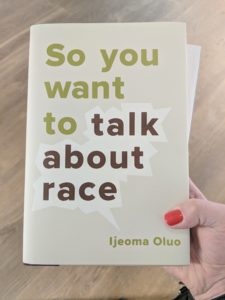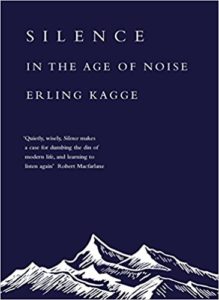Five Stars

Best for: Everyone interested in combating white supremacy.
In a nutshell: Author Ijeoma Oluo offers practical advice for ways to engage in conversations — and actions — to combat systemic racism.
Worth quoting: SO MUCH. But some of my favorites include:
“White Supremacy is this nation’s oldest pyramid scheme. Even those how have lost everything to the scheme are still hanging in there, waiting for their turn to cash out.”
“I think about every black and brown person, every queer person, every disabled person, who could be in the room with me, but isn’t, and I’m not proud. I’m heartbroken. We should not have a society where the value of marginalized people is determined by how well they can scale often impossible obstacles that others will never know.”
“It may not seem fair that you would take some of the blame for what has happened in the past, but what is truly unfair is the fact that people of color have to endure this every day.”
Why I chose it: Ms. Oluo is a writer based in the Seattle area, so I have been familiar with her work for while. You may be, too: she received a measure of national attention for this fantastic profile of the white woman who claims she is black. She has an amazing talent for writing that I have trouble describing without venturing into hyperbole. She gets to the point, cuts to the quick, and uses language in ways I am envious of. I was sad when I learned the release of this book in London came a month after the US release, but I finally got my hands on it on Sunday.
Review:
Go buy this book. Or get it from your library. If you are a white person, this book will help you understand how to be better at dismantling White Supremacy in all the ways that it works itself into our society. But this book isn’t just — or even primarily — for white people; it’s also a deeply personal exploration of how Ms. Oluo has experienced life as a black woman, and she speaks directly to other people of color throughout.
This could feel like a 101 exploration of how to be less racist (and sexist, and ableist). And in the best ways it does, and in the best ways it doesn’t. The topics are described in a way that I think anyone new to the work of dismantling White Supremacy will find easy to understand. Ms. Oluo never comes across as condescending or patronizing.At the same time, if you are a white person who has chosen to read about and learn about racism and ways to fight white supremacy, you will also learn so much here.
Think about that: Ms. Oluo has written a book that can speak to people new to this work and people who have been paying attention for awhile. That’s pretty bad ass.
I think what makes this book so relevant and necessary is how practical it is. I’ve reviewed books on social justice topics in the past (some focused on racism, some on sexism) that describe all of the problems that Ms. Oluo discusses, but don’t take that next step of offering practical, usable, realistic suggestions for what to do next.
Ms. Oluo does, and she does it so well. She starts by laying the groundwork in her first two chapters, which deftly put to rest the ideas that, say, class is really what we should focus on (“Is it really about race?) or that ‘reverse racism’ is a thing (“What is racism?”). She makes it clear that while white people and people of color may both be poor, the root cause is different, and so focusing just on class isn’t going to address the issues of race. And she makes it clear that she’s interested in looking at racism as the concept that includes the power behind it.
Once she sets up those definitions and bats away the straw men that so many people like to throw into discussions of race, she gets to the heart of many different questions or issues that come up in discussions of race. She speaks to the fear white people often have that we will fuck up when it comes to race (and we will fuck up). She provides one of the best discussions of privilege I’ve ever read. She talks about the need for intersectionality, and about affirmative action. She looks at what the school-to-prison pipeline is, why cultural appropriation is concerning, and breaks down why microaggressions are so insidious.
And in each of these chapters, she provides suggestions for how to address these things. She often even provides sample scripts to help guide the discussions.
The penultimate chapter is one that I think all white people should read, sit with, and read again. It’s called “I just got called racist, what do I do now?” Being white in the US means you are racist. It’s impossible not to be, but it doesn’t mean that you are aware of it or mean to be. But the reality is you (and I) are going to say or do something racist at some point, and if they feel safe to do so, someone will point it out to you (me). And in those moments we have the chance to learn. Being told we’ve done something racist is a kindness; it allows us to do better and be better.
*Note: If you purchase this in the London area, please take a moment to flip all the way through. Specifically, make sure that page 90 is followed by page 91 and not page 59. There was an issue with my copy that saw pages 91-120 missing, and pages 59-90 printed a second time. I returned the book and got a new one without the issue. Later in the day I found myself in another bookstore in London, and picked up a copy, and saw the same issue. I told both shops, so presumably they’ll alert the publisher and get fixed copies, but this book is SO GOOD that I don’t want you to buy it and then find that you’re missing 1/6th of it.




